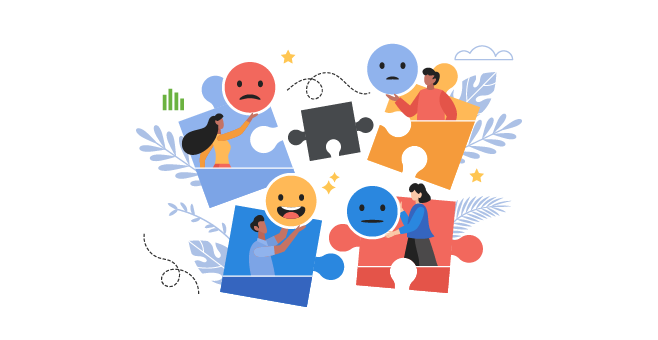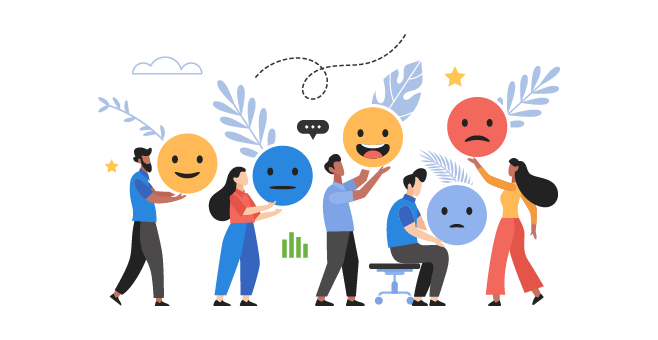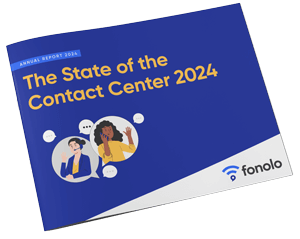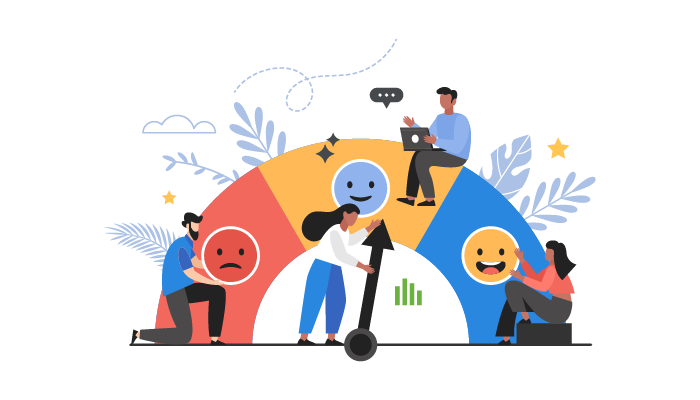Meeting customer expectations is tremendously important to most companies. According to Forrester, nearly 95% of leaders say that providing a good customer experience is a top strategic priority, and 75% want to use customer experience as a competitive advantage.
But it’s a big, crowded marketplace out there, full of consumers who want different things at different times on different channels. What do customers want? What do customers expect from your customer service department?
You would think that it’s hard to make a sweeping generalization about what “all customers” want, especially where customer service is concerned.
Let’s take a closer look at what research reveals about customers’ expectations.
10 Things Customers Want and Expect From Customer Service
1. Your customers want you to understand their needs
Customer frustration stems from a discontinuity between the expectation of a customer service interaction and what’s delivered. Nearly three-quarters of consumers expect you to understand their needs and expectations.
A study from the MIT Sloan Review found that customer service expectations had two levels: desired (what the customer hopes to obtain) and sufficient (what the customer would find acceptable). Of course, there’s a third level: unsatisfactory, where companies miss the mark entirely.
The difference between these relative levels is significant and is surely something reflected in your bottom line.
Many businesses have learned that it’s often advantageous to “underpromise and overdeliver” to increase the likelihood of exceeding customer expectations. Others take pride in high expectations, knowing full well that they can deliver the goods.
Whatever you do, make sure you understand and set those expectations with your customers from the beginning – and then deliver on them.
2. Your customers expect to communicate with you on their preferred channel
There’s a wealth of recent data citing the importance of channel preference on customer satisfaction. In a nutshell, customers expect companies to communicate with them on their preferred channel, be it in person, online, or on the phone. Today’s consumers expect to be able to communicate with you across at least ten different channels — depending on the type of inquiry.
Added to that, more than 85% of customers expect conversations with customer service representatives to move seamlessly and in real-time between channels. And that means no repeating themselves and their problem.
85% of customers expect a conversation to move seamlessly across channels - and hate repeating themselves. #custserve #CX Click To Tweet
Studies show that channel preference depends on the type of interaction.
For example, for “simple” inquiries (like “What’s my bank balance?”), self-service channels are preferred. However, as the question gets more complex, customers want to speak with a live agent by chat or on the phone.
Being where the customer is at any given time is the key to meeting customer expectations.

3. Your customers need you to respond quickly
It doesn’t matter if you’re in a store, on the phone, or online – no one likes to wait. Customers don’t care that your call volumes are spiking. That means you need to provide service in a reasonably quick fashion on all channels.
What’s reasonable, of course, depends on your customers and their channel preferences.
For example, one study shows that on Twitter, 53% of customers expect a brand to respond in under an hour. That number jumps to 72% when they have complaints. In the call center, it’s often hard to determine what the right service level is – and service levels are naturally different on different channels. For some good examples, see Shai’s recent blog post on the subject: “Manager’s Guide to Call Center Service Levels. “
When it comes time to do something about wait times, remember that technology can be your ally. For example, call-back solutions like Fonolo can help eliminate hold time while reducing abandon rates and telco costs in the call center.
4. Your customers crave a personalized experience
Though we live in a seemingly anonymous culture — where “self-service” is so prevalent — customers increasingly want a personalized experience when it matters most. Salesforce found that around 50% of consumers ignore communications that aren’t personalized to them. And 79% of consumers will also say that personalized service is more important than personalized marketing.
CRM technology allows businesses to have proper relationships with customers from the shop floor to the call center — take advantage of it. This approach can also extend to proactively contacting customers, for example, sending electronic communication about relevant promotions, follow-up calls to ensure satisfaction, etc.
Fostering relationships with customers can significantly increase the likelihood of exceeding their expectations, turning them into advocates of your brand.
And it’s well worth the investment: even just the perception of personalization could significantly increase revenue.
79% of consumers say that personalized service is more important than personalized marketing #custserve #personalization Click To Tweet5. Your customers want you to solve their problems
Only 12% of customers believe companies when they claim to ‘put the customer first.’
At the root of every customer inquiry is a desire for a quick resolution. It doesn’t take a rocket scientist to understand that customers don’t want to jump through hoops to get their problems fixed and questions answered.
Empowering your front-line agents so they can resolve customer issues is key. With each transfer, subsequent call, or email, customers lose patience with your organization, resulting in a loss of goodwill, which can significantly affect your ability to retain and grow your customer base.
Solving customer problems right away is a surefire way to avoid issues from your customers down the line.
6. Your customers wish you would listen to them
Just like anyone, your customers want you to listen to them. Really listen. You may collect feedback, but do you act on it? Around half of people surveyed believe that companies don’t take action on customer feedback.
Consumers have a louder voice than ever, and if you’re not listening to them, someone else will. Overwhelmingly, customers want to give you feedback — more than 85% of customers expect you to allow them to provide feedback.
More than half of people don’t believe that companies take action on the feedback they receive. #custserve #feedback Click To TweetAnd companies that let consumer expectations and feedback guide them dominate many industries today — Amazon being the most obvious example. By making it easier for customers to get what they wanted and creating products based directly on feedback, Amazon has obliterated many traditional retailers in their space.
7. Your customers like you to be proactive
People strongly favor companies that are proactive when it comes to customer service — both personal notifications about service issues and more public social media statements.
Customer service has long been in a reactionary trench; don’t wait for your customers to reach out to you with their problems and questions. Being proactive is how you present your brand as ‘going the extra mile’ for your customers.
Don’t wait for your customers to reach out with their problems - being proactive shows you care. #custserve #feedback Click To TweetCreate opportunities for them to provide feedback at any point. Formalize the processes around when you reach out to specific customers, depending on how they interact with your content. Make customer focus groups a regular part of your engagement strategy.

8. Your customers love to be surprised
Customers love to be surprised. Surprise can light up the pleasure area of your brain the same way drugs do, indicating humans are designed to crave the unexpected.
Surprise is a potent tool for shaping the customer experience. And remember, you don’t necessarily have to spend a lot of money. A handwritten note in their delivery, a small discount, or a birthday card could be enough.
Based on some of our earlier stats, they’ll probably be surprised if you’re proactive about solving their problems or listen to their feedback!
9. Your customers prefer saving time over money
Contrary to what many believe, most people value their time over money. The best way to sell someone something is by presenting it as something that can either save them time or improve the quality of the time they have.
That’s why McDonald’s marketing strategy focuses on ‘happiness’ and not on ‘cheap food.’ Another example of this is cheap alcohol. This is particularly important for certain products, but it works with anything.
Time is of the essence now more than ever. The majority of customers feel that valuing their time is the most important thing a company can do.
10. Your customers wish you would give them consistent answers
Besides repeating themselves, the customers hate the most is inconsistency. More than three-quarters of customers say that getting inconsistent answers from support agents is a major frustration for them.
More than 75% of people say that getting inconsistent answers from customer support is a major frustration. #custserve #cx Click To Tweet
With most consumers using multiple channels to communicate with you, it’s time to make sure that it feels like a single conversation. Are you giving customers the same answers and the same level of service across all your channels?
Understand Your Customers’ Needs and Surpass Them
The key to delivering excellent customer service — and a chorus of customers advocating your brand — is truly understanding your customers’ needs and expectations. Using tools like MaxDiff to truly understand customer expectations will set you apart from other brands and give you a real insight into how to create loyal customers time and time again.
Setting Customer Expectations
Once upon a time, a disappointed customer was a manageable event that could be contained. No doubt, a few neighbors and friends might hear about a terrible meal, a long wait on hold, or a trip spoiled by lost luggage. But a company could respond and make it right.
Today, the court of public opinion reaches as far and wide as social media networks can stretch. For businesses and service providers, customer service faux pas are more exposed than ever. Disappointed and angry customers can easily take to Twitter, Instagram, TikTok, or any number of digital channels to publicly ‘out’ companies like yours for falling short. Hundreds, thousands, or even millions of people might get the message that your brand has come up short.
This is why setting and managing customer expectations and their perceptions is key. Setting expectations can ultimately protect your brand from online backlash. If your customer knows everything to expect early on, from return and exchange procedures to customer service wait times, there will be no surprises that will prompt them to ‘out’ your business online.
What influences customer expectations?
Customers approach your brand and its products and services with preconceptions in mind. They expect that your brand will work in a way that benefits them, their lifestyle, their work environment, or a particular project they are working on. These expectations are formed by several factors, including:
- Marketing and advertising. Chances are the expectations customers bring to the table come directly from your marketing and advertising promises.
- Lived experience. Most customers have had a previous experience with a product or service similar to yours and thus have a working understanding of how things should work.
- Other people. Word-of-mouth recommendations and online reviews by other customers go a long way in forming preconceptions of a brand and its customer service operations.
With all this in mind, what initial steps can your brand take to manage customer expectations? Read these five tips to help set and exceed customer’s expectations.
Setting Customer Expectations: 5 Tips
1. Communicate what to expect at every opportunity, on every channel
Customers will be less likely to roast you online or combat one of your customer service professionals if they are made aware of what to expect in every place you can think of: your website, social media channels, advertising, any recorded messaging on your IVR, on your product pages, and at checkout.
Use these opportunities to let customers know what to expect from a product or customer service standpoint. This information can include things like customer wait times and response times, customer service channels, business hours, return and exchange policies, and more.
TIP:
Communicating estimated hold times can help manage customer expectations, but it doesn’t relieve the frustration of having to wait on hold. Find out how call-back technology can help!
2. Scrutinize your customer’s journey by putting yourself in their shoes
If you’re faced with an influx of bad social media mentions, and you don’t know why, try putting yourself in the customer’s position to understand their experience with your brand. Regularly reviewing every point of the customer journey can help you identify gaps in service, manage customer’s expectations, and tweak your messaging.
Put on your analytical glasses and ask yourself: At what points can we better educate the customer on what to expect? Where can we collect customer feedback and reviews, and how can we use that data to better position our brand?
3. Set realistic customer expectations with honest marketing tactics
One of the most reliable ways to avoid unrealistic customer expectations is to be honest. Employing honest marketing and messaging about your product and how it works, and the minutia around hours, returns, and customer service levels, protects you from backlash and protects your customers from future frustration.
Avoid bold claims and embrace the truth; your honesty will be refreshing, and it will promote brand trust. If you’re unsure of what constitutes honest marketing, check out these advertising and marketing basics care of the Federal Trade Commission, developed to protect American consumers from deceptive or unfair advertising. These can help you grow your understanding of how to communicate honestly and openly to set customer expectations.
4. Build consistency across departments
Consistently meeting and exceeding customer expectations is a huge part of building brand loyalty. If you deliver an inconsistent experience, that is what you will become known for. Make sure all your departments, brands, and locations are aligned on:
- What your company stands for.
- Customer procedures.
- How your product or service is meant to work.
- The quality of service/product that is being promoted to the customer.
- How to consistently meet those expectations.
5. Train your employees to meet customer’s expectations
You can have all the educational and truthful messaging in the world, but if your staff is not consistently meeting consumer expectations, you still have a problem.
Managing customer expectations is mainly about ensuring your employees can meet the established service levels. Teaching them how to manage a customer, how all services and operations within your company work, and generally making them subject matter experts on your brand will improve your customer’s opinion of you, your product, and your service.


